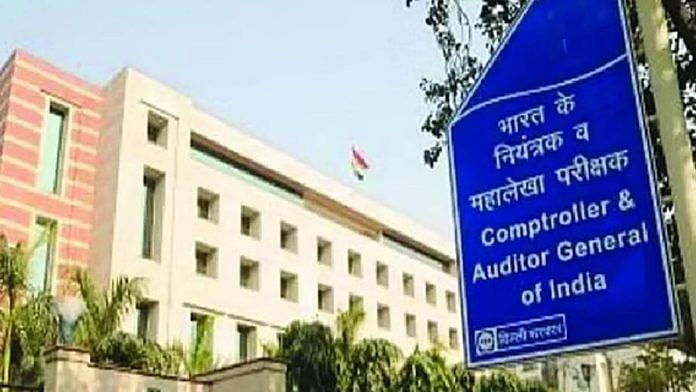New Delhi: The Government of India understated its external debt by as much as Rs 2 lakh crore in fiscal 2021-2022 — running afoul of its own laws — the Comptroller and Auditor General of India (CAG) has said in a report.
The CAG, in a report made public in August and pertaining to financial year 2021-2022, highlighted a tendency by the Narendra Modi government to bury important information in footnotes rather than report it in the main body of its accounts. Some of this information was “crucial in nature” and thus needed a more significant disclosure, the CAG said.
The CAG, in a section titled “depiction of critical information through footnotes”, found that the main section of the government’s accounts for the year 2021-22 showed the external debt of the Union government to be Rs 4.39 lakh crore based on a “historical” exchange rate. However, a footnote disclosed that at the latest exchange rate for the period (31 March, 2022), this debt would actually have been Rs 6.58 lakh crore — Rs 2.19 lakh crore higher.
This, the CAG said, was a violation of the provisions of the Fiscal Responsibility and Budget Management (FRBM) Act, 2003, which lays out the rules the government should adhere to in the interests of good, stable, and transparent fiscal policy.
“This disclosure of the value of external debt only through a footnote affected the transparency of the accounts and may also be seen in the light of Rule 2(aa) of FRBM Act, 2003, wherein the definition of Union Government Debt includes External Debt valued at current exchange rates,” the CAG report says.
According to the FRBM Act, government debt at any point of time includes, among other things, “the total outstanding liabilities of the central government on the security of the Consolidated Fund of India, including external debt valued at current exchange rates”.
Also Read: Modi can’t prove India is 5th largest economy. Data will fail him
Important disclosures buried
The CAG also found other instances of the government leaving important information in the footnotes of its accounts.
According to the ‘Liabilities of the Central Government’ statement released by the Centre, the total of liabilities of the Union government under the accounting head ‘Small Savings and Provident Funds’, as on 31 March, 2022, were Rs 6,01,445.58 crore.
However, the CAG found that information on “other liabilities” of the government with regard to this accounting head, and also some of its related investments, were made only through footnotes.
“Thus, depiction of Small Savings Liabilities amounting to Rs 6,23,006.29 crore through a footnote, and not as part of the main body of the Statement or depicting the consolidated picture at any place, did not present an appropriate picture of Public Account Liabilities of the Union Government,” the CAG says in the report.
The CAG said it had raised the issue of the improper use of footnotes in the report for FY21 as well, and had suggested then that the government should introduce a section where all such disclosures could be made in a consolidated form “to aid readability and transparency”.
Cesses unused, problem of ‘other expenditure’
The CAG also found that several cesses the government had collected from the public were unused, lying idle, or had been misappropriated for uses other than what they were intended for.
A cess is a form of tax the government collects for a particular purpose, the proceeds of which it does not need to share with the states. This has become a sore point between the Centre and the states, with the latter alleging that the Centre was increasingly using cesses rather than taxes, as it would not then need to share the proceeds.
An example of cesses lying unused, as noted by the CAG, was the Health and Education Cess collected in 2021-22, a part of which was to go towards two funds — Madhyamik and Uchchtar Shiksha Kosh (MUSK) and Pradhan Mantri Swasthya Suraksha Nidhi (PMSSN).
“During FY 2021-22, an amount of Rs 52,732 crore was collected towards Health and Education Cess, out of which Rs 31,788 crore (60 per cent) was transferred to Prarambhik Shiksha Kosh,” the CAG report says.
“For the remaining Reserve Funds, in spite of Cabinet’s approval for their creation i.e. MUSK (July 2017) and PMSSN (March 2021), both are yet to be operationalised due to non-finalisation of their accounting procedures,” it adds.
Similarly, the CAG found that in 2021-22, the government collected Rs 10,376 crore under the Universal Access Levy (UAL), a cess aimed at financing the Universal Service Obligation Fund — which is meant to help defray the cost of providing mobile services in remote areas. However, only Rs 8,300 crore was actually transferred to the fund.
“Thus, there was a short transfer of UAL collected during the year to USO Fund amounting to Rs 2,076 crore,” the CAG said. “This amount was retained in the Consolidated Fund of India and was available for use for purposes other than for which it was levied.”
The CAG also said that, despite repeated attempts by it to dissuade the Centre, various government departments still listed large parts of their expenditure under the catch-all and opaque accounting head of “other expenditure”.
“Classifying the expenditure of certain outlays at appropriate level is necessary for ensuring the transparency in books of accounts, which also enables to quantify the expenditure activity-wise for the purpose of management as well as monitoring,” the CAG report states.
“Hence, repeated use of Minor Head 800 [which is titled ‘other expenditure’] results in opaqueness in accounts and needs to be curtailed,” it added.
(Edited by Nida Fatima Siddiqui)
Also Read: CAG report flags Railways’ worst-ever operating ratio in FY22. Rs 100 earned for every Rs 107 spent



